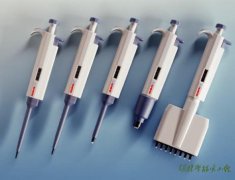(ISP)国际链霉菌计划培养基
发布日期:2020-07-24 09:19
来源:International Journal of Syste
作者:Shirling E B
浏览次数:
Shirling E B, Gottlieb D Methods for characterization of Streptomyces species[J] International Journal of Systematic Bacteriology, 1966, 16(3): 313-340
 |
Methods for characterization of Streptomyces species |
Trace salts solution(用于ISP3,ISP4,ISP5和ISP7)
FeSO4·7H2O 0.1 g
MnCl2·4H2O 0.1 g
ZnSO4·7H2O 0.1 g
Distilled water 100.0 mL
ISP 1: Tryptone-yeast extract broth
Bacto-Tryptone 5.0 g
Bacto-Yeast Extract 3.0 g
Distilled water 1.0 liter
pH 7.0-7.2 before autoclaving
本培养基分装在直径2 cm以上的试管中用于培养研究,或50ml/250ml锥形瓶分装后用于培养研究。
ISP 2: Yeast extract-malt agar
Bacto-Yeast Extract (Difco) 4.0 g
Bacto-Malt Extract (Difco) 10.0 g
Bacto-Dextrose (Difco) 4.0 g
Distilled water 1.0 liter
Adjust to pH 7.3, then add
Bacto agar 20.0 g
Liquefy by steaming at 100°C for 15-20 minutes.
该培养基制备成试管斜面用于菌种的保藏。
ISP 3: Oatmeal agar
Oatmeal 20.0 g
Agar 18.0 g
Cook or steam 20 g oatmeal in 1000 ml distilled water for 20 minutes
Filter through cheese cloth
Add distilled water to restore volume of filtrate to 1000 mL
Trace salts solution 1.0 mL
Adjust to pH 7.2 with NaOH
Add 18 g agar; liquefy by steaming at 100°C for 15-20 minutes.
25ml/90mm皿平板用于形态的观察。
ISP 4: Inorganic salts-starch agar
Solution Ⅰ: Difco soluble starch 10.0 g
Make a paste of the starch with a small amount of cold distilled water and bring to a volume of 500 mL.
Solution Ⅱ:
K2HPO4 (anhydrous basis) 1.0 g
MgSO4·7H2O 1.0 g
NaCl 1.0 g
(NH4)2SO4 2.0 g
CaCO3 2.0 g
Distilled water 500 mL
Trace salts solution 1.0 ml
pH should be between 7.0 and 7.4. Do not adjust if it is within this range.
Mix starch suspension and salts solution.
Add agar 20.0 g
Liquefy agar by steaming at 100°C for 15-20 minutes.
ISP 5: Glycerol-asparagine agar
L-asparagine (anhydrous basis) 1.0 g
Glycerol 10.0 g
K2HPO4 (anhydrous basis) 1.0 g
Distilled water 1.0 liter
Trace salts solution 1.0 mL
The pH of this solution is about 7.0-7.4. Do not adjust if it is within this range.
Agar 20.0 g
Liquefy agar by steaming at 100°C for 15-20 minutes.
ISP 6: Peptone-yeast extract iron agar
Bacto-Peptone Iron Agar, dehydrated (Difco) 36.0 g
Bacto-Yeast Extract (Difco) 1.0 g
Distilled water 1.0 liter
pH should be 7.0-7.2 before autoclaving; adjust if necessary.
Liquefy agar by steaming at 100°C for 15-20 minutes.
Peptone Iron Agar: per liter of water
Peptone 15 g
Proteose peptone 5 g
Ferric ammonium citrate 0.5g
Dipotassium phosphate 1 g
Sodium thiosulfate 0.08 g
Agar 15 g
ISP 7: Tyrosine agar
Glycerol 15.0 g
L-tyrosine (Difco) 0.5 g
L-asparagine (Difco) 1.0 g
K2HPO4 (anhydrous basis) 0.5 g
MgSO4·7H2O 0.5 g
NaCl 0.5 g
FeSO4·7H2O 0.01 g
Distilled water 1.0 liter
Trace salts solution 1.0 mL
Adjust to pH 7.2-7.4
Bacto-Agar 20.0 g
Liquefy by steaming at 100°C for 15-20 minutes.
ISP9:Carbon utilization medium
Carbon source:
No carbon source (negative control)
D-glucose (positive control)
L-arabinose
Sucrose
D-fructose
D-xylose
Rhamnose
I-inositol
Raffinose
D-mannitol
Cellulose
Pridham and Gottlieb trace salts (only 1 ml of this solution is used per liter of final medium)
CuSO4·5H2O. . . . . . . . . . . . . 0.64 g
FeSO4·7H2O . . . . . . . . . . . . . 0.11 g
MnCl2·4H2O . . . . . . . . . . . . . 0.79 g
ZnSO4·7H2O. . . . . . . . . . . . . 0.15 g
Distilled water . . . . . . . . . . . 100.0 ml
Store at 3-5°C until required for use. Bring to room temperature before using. Prepare fresh solution each month. Disregard any precipitate or scale (probably iron salts) that forms during storage. (Only 1 ml of this solution will be used in the medium.)
Basal mineral salts agar (use analytical reagent grade chemicals)
(NH4)2SO4. . . . . . . . . . . . . . 2.64g
KH2PO4·anhydrous . . . . . . . 2.38 g
K2HPO4·3H2O . . . . . . . . . . 5.65 g
MgSO4·7H2O . . . . . . . . . . . 1.00 g
Pridham and Cottlieb trace salts (B) 1.00 ml
Distilled water . . . . . . . . . . . 1.00 liter
Dissolve ingredients and check pH. Adjust, if necessary, to 6.8-7.0 with 1 N NaOH or 1 N HC1.
Add agar (Difco) . . . . . . . . . . 15.0 g
Sterilize basal agar medium, cool it to 60'C and add sterile carbon source (A) aseptically to give a concentration of approximately 1%. Agitate the mixture and pour 25 ml of medium per dish into 9 cm Petri dishes. Each organism will require 2 Petri dishes with no carbon (as a negative control) plus duplicate plates for each carbon source tested.
ISP2/ISP3/IPS4/ISP5用于形态和颜色生成的观察,每90mm标准培养皿倒25ml培养基。接种过程中采用特定的接种方法,参考本资料来源文献操作。



